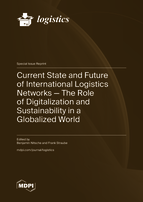Current State and Future of International Logistics Networks—The Role of Digitalization and Sustainability in a Globalized World
A special issue of Logistics (ISSN 2305-6290).
Deadline for manuscript submissions: closed (20 May 2023) | Viewed by 58121
Special Issue Editors
Interests: international logistics networks; supply chain volatility; automation in logistics and supply chain management; autonomous logistics networks; supply chain twins; agri-food supply chains; the role of Africa in international logistics networks
Special Issues, Collections and Topics in MDPI journals
Special Issue Information
Dear Colleagues,
International logistics networks are in constant change and are facing more and more challenges while trying to cope with increasing dynamics and uncertainties. Due to the global and cross-industry relevance of logistics for the economy and society, logistics has always been exposed to various micro- and macroeconomic trends and challenges, and managers are constantly asking themselves which future development paths might emerge for international logistics networks. In this complex environment, logistics managers must tackle several trends simultaneously. Managing the ever-present cost pressure in logistics thereby becomes even more challenging when trying to manage increasing levels and different types of volatility [1], while also dealing with several unexpected disruptions that require new approaches to resilience. Additionally, current geopolitical tensions are having an impact on how managers adapt their logistics networks. Governments and economic regions are acknowledging the important role of logistics for economic growth and stability, leading to the direct involvement of governments into the development of global logistics networks, whether through China’s global Belt and Road Initiative [2], the Global Gateway initiative of the European Union, or other important programs.
The more complex and globally distributed the associated value networks become, the greater the impact of uncertainties on the planning and management of logistics networks. Moreover, further trends have been emerging for some time that are additionally influencing the design of international logistics networks. Digitalization and technologization in logistics play a major role here, as they have a particularly strong influence on international logistics networks. Additionally, the ever-increasing need for sustainable logistics solutions is also driving developments. Although these trends were also considered as important in the past decade by academics and practitioners alike, many studies assume that the current decade (2020-29) in particular will shape international logistics to a special degree. On the one hand, increasingly rapid technological progress is now making it possible to leverage the already known potential of digitalization. This means that fully automated or even partially automated informational processes in logistics networks could become reality within this decade [3–5]. In addition, artificial intelligence and machine learning approaches offer new opportunities, and Digital Twin technologies promise real-time visibility for global networks and new approaches to manage and control international logistics networks more proactively in the near future, due to enhanced simulation opportunities [6]. On the other hand, the need for more sustainability in logistics, which has been known for a long time, must now also be translated into concrete solutions. In addition to stronger CO2 pricing, further regulatory interventions are to be expected, not only on the ecological but also the social level of sustainability (e.g., through Supply Chain Acts). Furthermore, the integration of low-income countries into global value creation networks is one of the core tasks that has to be tackled by companies together with governmental actors in order to create more sustainable international logistics networks in the future. Here, the integration of Sub-Saharan African countries into these value streams is of especially high importance. Many Sub-Saharan African countries have a high population growth, big economic growth potential, and a huge drive for digitalization, and therefore have the opportunity to leapfrog others in their logistics performance, especially by means of digitalization and technologization, if mistakes made by industrialized countries in the past are being avoided. Moreover, the improvement of sustainable transportation systems in these countries plays a major role in integrating them into global value streams and to foster economic growth and wealth [7].
The already complex task of managing international logistics networks was further complicated right at the beginning of this decade by the sudden emergence of the COVID-19 pandemic, which is spreading into all areas of life and also has far-reaching consequences for the current and future planning, design, and management of international logistics networks. Already known trends in international logistics are now becoming even more important, but also the previous problems of globalization and poorly executed digital transformation are now becoming more evident even faster [8,9]. Traditional design approaches for international logistics networks are being phased out to test new methods, and the question arises regarding how globally dispersed future logistics networks can and will be in the wake of the megatrends of digitalization and sustainability and what new forms of resilience might look like.
To contribute to the necessary discussions about the aforementioned topics and trends, this Special Issue aims to bring together scientific contributions on key topics in international logistics. Authors are cordially invited to submit original research papers, review articles, empirical studies and case studies for this Special Issue of Logistics. Manuscripts or papers can be submitted on the following topics (non-exhaustive list):
- Managing risks, dynamics and volatility in international logistics networks;
- New management concepts, tools and approaches to achieve more sustainable international logistics networks;
- Use of technology for logistics performance improvement (e.g., digital supply chain twins or blockchain applications);
- Utilization of artificial intelligence and machine learning for managing international logistics networks on operational and tactical levels;
- Novel approaches to achieve resilience and flexibility in international logistics networks;
- Process automation and autonomization in international logistics networks;
- Post-pandemic trends and strategies for global logistics;
- New business models for international logistics service providers (e.g., logistics platforms);
- Assessment of current state and future directions of global freight market;
- Integration of low- and mid-income countries (e.g., from Sub-Saharan Africa) into global value streams to foster intra- and inter-continental trade;
- The role of governments in improving logistics systems;
- Investigations of international infrastructure programs such as the Belt and Road initiative/New Silk Road or the EU Global Gateway and their effect on logistics networks;
- Implications of Supply Chain Acts on the future design and management of logistics networks;
- Case studies (especially related to low- and mid-income countries, i.e., in Sub-Saharan Africa).
Other articles related to the broad topic of international logistics networks are highly welcome. We are looking forward to receiving your submissions.
Recommended sources:
- Nitsche, B.; Durach, C.F. Much Discussed, Little Conceptualized: Supply Chain Volatility. International Journal of Physical Distribution & Logistics Management 2018, 48, 866–886, doi:10.1108/IJPDLM-02-2017-0078.
- Nitsche, B. Decrypting the Belt and Road Initiative: Barriers and Development Paths for Global Logistics Networks. Sustainability 2020, 12, 9110, doi:10.3390/su12219110.
- Straube, F. (Ed.); Junge, A.L.; Verhoeven, P.; Reipert, J.; Mansfeld, M. Pathway of Digital Transformation in Logistics: Best Practice Concepts and Future Developments; Scientific Series Logistics at the Berlin Institute of Technology. Special Edition; Universitätsverlag der TU Berlin: Berlin, 2019; ISBN 978-3-7983-3094-8.
- Nitsche, B.; Straube, F.; Wirth, M. Application Areas and Antecedents of Automation in Logistics and Supply Chain Management: A Conceptual Framework. Supply Chain Forum: An International Journal 2021, 1–17, doi:10.1080/16258312.2021.1934106.
- Nitsche, B. Exploring the Potentials of Automation in Logistics and Supply Chain Management: Paving the Way for Autonomous Supply Chains. Logistics 2021, 5, 51, doi:10.3390/logistics5030051.
- Gerlach, B.; Zarnitz, S.; Nitsche, B.; Straube, F. Digital Supply Chain Twins—Conceptual Clarification, Use Cases and Benefits. Logistics 2021, 5, 86, doi:10.3390/logistics5040086.
- Nitsche, B. Embracing the Potentials of Intermodal Transport in Ethiopia: Strategies to Facilitate Export-Led Growth. Sustainability 2021, 13, 1–21, doi:10.3390/su13042208.
- Nitsche, B.; Straube, F. Defining the “New Normal” in International Logistics Networks: Lessons Learned and Implications of the COVID-19 Pandemic. WiSt 2021, 50, 16–25.
- Straube, F.; Nitsche, B. Heading into “The New Normal”: Potential Development Paths of International Logistics Networks in the Wake of the Coronavirus Pandemic. International Transportation 2020, 72, 31–35.
Dr. Benjamin Nitsche
Prof. Dr. Frank Straube
Guest Editors
Manuscript Submission Information
Manuscripts should be submitted online at www.mdpi.com by registering and logging in to this website. Once you are registered, click here to go to the submission form. Manuscripts can be submitted until the deadline. All submissions that pass pre-check are peer-reviewed. Accepted papers will be published continuously in the journal (as soon as accepted) and will be listed together on the special issue website. Research articles, review articles as well as short communications are invited. For planned papers, a title and short abstract (about 100 words) can be sent to the Editorial Office for announcement on this website.
Submitted manuscripts should not have been published previously, nor be under consideration for publication elsewhere (except conference proceedings papers). All manuscripts are thoroughly refereed through a single-blind peer-review process. A guide for authors and other relevant information for submission of manuscripts is available on the Instructions for Authors page. Logistics is an international peer-reviewed open access quarterly journal published by MDPI.
Please visit the Instructions for Authors page before submitting a manuscript. The Article Processing Charge (APC) for publication in this open access journal is 1400 CHF (Swiss Francs). Submitted papers should be well formatted and use good English. Authors may use MDPI's English editing service prior to publication or during author revisions.
Keywords
- international logistics
- digitalization
- sustainability
- globalization
- localization
- resilience
- artificial intelligence
- digital supply chain twins
- blockchain
- low-income countries







